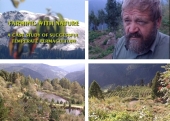You don't need flowing water to grow good weeping willow trees, you just have to keep the soil wet
enough for them.
Thick layers of mulch under a willow goes a long way at keeping the moisture in the soil for them.
I like to use
wood chips for this since as they decay they
feed the soil organisms which then feed the tree, as I replenish the wood chips I keep the circle going.
Locating the natural breezes on your
land is another key to being able to grow cooler weather plants in the south.
Add shading trees to this area and you can get quite a temperature drop. (I have two places where it will be 20 degrees cooler in the hottest part of the day)
Steep hugels are great for creating microclimates and you can make use of these for lots of cooler weather items like lettuces, radishes, beets, carrots, kale, mints, and many others that like it a bit cooler than our hot southern summers.









